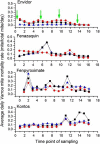Miticidal activity of fenazaquin and fenpyroximate against Varroa destructor, an ectoparasite of Apis mellifera
- PMID: 34994089
- PMCID: PMC9303763
- DOI: 10.1002/ps.6788
Miticidal activity of fenazaquin and fenpyroximate against Varroa destructor, an ectoparasite of Apis mellifera
Abstract
Background: The Varroa mite (Varroa destructor) is an ectoparasite that can affect the health of honey bees (Apis mellifera) and contributes to the loss of colony productivity. The limited availability of Varroacides with different modes of action in Canada has resulted in the development of chemical resistance in mite populations. Therefore, an urgent need to evaluate new potential miticides that are safe for bees and exhibit high efficacy against Varroa exists. In this study, the acute contact toxicity of 26 active ingredients (19 chemical classes), already available on the market, was evaluated on V. destructor and A. mellifera under laboratory conditions using an apiarium bioassay. In this assay, groups of Varroa-infested worker bees were exposed to different dilutions of candidate compounds. In semi-field trials, Varroa-infested honey bees were randomly treated with four vetted candidate compounds from the apiarium assay in mini-colonies.
Results: Among tested compounds, fenazaquin (quinazoline class) and fenpyroximate (pyrazole class) had higher mite mortality and lower bee mortality over a 24 h exposure period in apiariums. These two compounds, plus spirotetramat and spirodiclofen, were selected for semi-field evaluation based on the findings of the apiarium bioassay trials and previous laboratory studies. Consistent with the apiarium bioassay, semi-field results showed fenazaquin and fenpyroximate had high efficacy (>80%), reducing Varroa abundance by 80% and 68%, respectively.
Conclusion: These findings suggest that fenazaquin would be an effective Varroacide, along with fenpyroximate, which was previously registered for in-hive use as Hivastan. Both compounds have the potential to provide beekeepers with an alternative option for managing Varroa mites in honey bee colonies. © 2022 The Authors. Pest Management Science published by John Wiley & Sons Ltd on behalf of Society of Chemical Industry.
Keywords: Varroa mite; apiarium; fenazaquin; fenpyroximate; honey bee.
© 2022 The Authors. Pest Management Science published by John Wiley & Sons Ltd on behalf of Society of Chemical Industry.
Conflict of interest statement
The authors declare that they have no competing interests.
Figures








Similar articles
-
New bioassay cage methodology for in vitro studies on Varroa destructor and Apis mellifera.PLoS One. 2021 Apr 26;16(4):e0250594. doi: 10.1371/journal.pone.0250594. eCollection 2021. PLoS One. 2021. PMID: 33901245 Free PMC article.
-
Evaluation of potential miticide toxicity to Varroa destructor and honey bees, Apis mellifera, under laboratory conditions.Sci Rep. 2020 Dec 9;10(1):21529. doi: 10.1038/s41598-020-78561-2. Sci Rep. 2020. PMID: 33299084 Free PMC article.
-
Comparing the efficacy of synthetic Varroacides and Varroa destructor phenotypic resistance using Apiarium and Mason jar bioassay techniques.Pest Manag Sci. 2024 Mar;80(3):1577-1592. doi: 10.1002/ps.7891. Epub 2023 Dec 1. Pest Manag Sci. 2024. PMID: 37974358
-
Varroa destructor: how does it harm Apis mellifera honey bees and what can be done about it?Emerg Top Life Sci. 2020 Jul 2;4(1):45-57. doi: 10.1042/ETLS20190125. Emerg Top Life Sci. 2020. PMID: 32537655 Free PMC article. Review.
-
A scoping review on the effects of Varroa mite (Varroa destructor) on global honey bee decline.Sci Total Environ. 2024 Jan 1;906:167492. doi: 10.1016/j.scitotenv.2023.167492. Epub 2023 Sep 29. Sci Total Environ. 2024. PMID: 37778563
Cited by
-
Adjuvants to improve efficacy of miticides in managed honey bee (Apis mellifera) colonies to control Varroa destructor.PLoS One. 2025 Jun 17;20(6):e0320037. doi: 10.1371/journal.pone.0320037. eCollection 2025. PLoS One. 2025. PMID: 40526628 Free PMC article.
-
Effects of dialkoxybenzenes against Varroa destructor and identification of 1-allyloxy-4-propoxybenzene as a promising acaricide candidate.Sci Rep. 2023 Jul 11;13(1):11195. doi: 10.1038/s41598-023-38187-6. Sci Rep. 2023. PMID: 37433810 Free PMC article.
-
Arising amitraz and pyrethroids resistance mutations in the ectoparasitic Varroa destructor mite in Canada.Sci Rep. 2025 Jan 10;15(1):1587. doi: 10.1038/s41598-025-85279-6. Sci Rep. 2025. PMID: 39794392 Free PMC article.
References
-
- Naeem M, Huang J, Zhang S, Luo S, Liu Y, Zhang H et al., Diagnostic indicators of wild pollinators for biodiversity monitoring in long‐term conservation. Sci Total Environ 708:135–231 (2020). - PubMed
-
- Loreau M, Naeem S, Inchausti P, Bengtsson J, Grime JP, Hector A et al., Biodiversity and ecosystem functioning: current knowledge and future challenges. Science 294:804–808 (2001). - PubMed
-
- Costanza R, D'Arge R, DeGroot R, Farber S, Grasso M, Hannon B et al., The value of the world's ecosystem services and natural capital. Nature 387:253–260 (1997).
-
- Kearns CA, Inouye DW and Waser NM, Endangered mutualisms: the conservation of plant–pollinator interactions. Annu Rev Ecol Syst 29:83–112 (1998).
-
- Gallai N, Salles JM, Settele J and Vaissiere BE, Economic valuation of the vulnerability of world agriculture confronted with pollinator decline. Ecol Econ 68:810–821 (2009).
MeSH terms
Substances
Grants and funding
LinkOut - more resources
Full Text Sources

